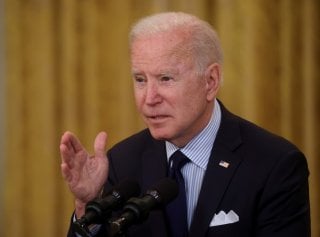$350,000,000,000 Is Coming: Stimulus Payments for Local Governments
According to USA Today, the money will be distributed in a pair of tranches: One now, and another a year from now. The money must be spent by the end of 2024.
The American Rescue Plan, when it was passed by Congress in March, allocated $350 billion in emergency funds for state and local governments-much more than the $150 billion allocated by the CARES Act in 2020. Now, that money is finally available.
Earlier this week, the Department of the Treasury launched a web portal, dedicated to what’s described as Coronavirus State and Local Fiscal Recovery Funds.
“The Coronavirus State and Local Fiscal Recovery Funds provide a substantial infusion of resources to help turn the tide on the pandemic, address its economic fallout, and lay the foundation for a strong and equitable recovery,” the website says.
The funding, per the website, has several objectives-to directly support coronavirus relief efforts, to replace revenue that the local governments lost in the pandemic, to help stabilize homes and businesses, and to deal with more systemic challenges.
“The Coronavirus State and Local Fiscal Recovery Funds provide substantial flexibility for each government to meet local needs—including support for households, small businesses, impacted industries, essential workers, and the communities hardest hit by the crisis,” the site says. “These funds can also be used to make necessary investments in water, sewer, and broadband infrastructure.”
Governments can click the “request funding” button on the site.
According to USA Today, the money will be distributed in a pair of tranches: One now, and another a year from now. The money must be spent by the end of 2024.
Reports earlier this month stated that many city and state governments weren’t exactly sure how getting the money from that program would work, and had questions as to what they were allowed to do. The portal, seemingly, will answer some of those questions. For instance, local governments cannot use the money to offset tax cuts enacted after March 3, a rule that, per USA Today, has promoted Ohio’s state attorney general to sue the administration.
In addition, water and sewer and broadband infrastructure are acceptable uses for the money from the Rescue Plan, although most other forms of infrastructure spending are not allowed under the plan.
“The money we're going to be distributing now is going to make it possible for an awful lot of educators, first-responders and sanitation workers to go back to work,” President Biden said Monday, according to the USA Today account.
“Today, the Biden Administration has taken a strong step to protect the livelihoods of the millions of frontline heroic workers who are the lifeblood of our economy,” House Speaker Nancy Pelosi, who was instrumental in marshaling the votes for the package, said in a statement.
“This important announcement is a tribute to House Democrats’ commitment to robust state, local, territorial and tribal funding. It will save jobs, prevent layoffs, keep services running and help our economy recover from crisis, while prioritizing equity and flexibility for governments.”
Stephen Silver, a technology writer for The National Interest, is a journalist, essayist and film critic, who is also a contributor to The Philadelphia Inquirer, Philly Voice, Philadelphia Weekly, the Jewish Telegraphic Agency, Living Life Fearless, Backstage magazine, Broad Street Review and Splice Today. The co-founder of the Philadelphia Film Critics Circle, Stephen lives in suburban Philadelphia with his wife and two sons. Follow him on Twitter at @StephenSilver.

